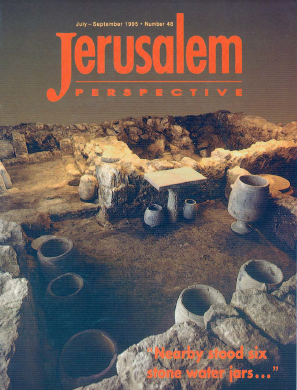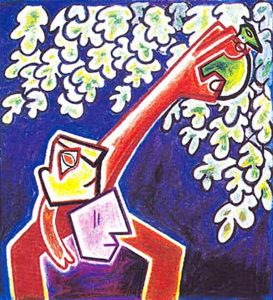Esteeming the Parable
Parables, both rabbinic and synoptic, have roots running deep in the fertile soil of Hebrew Scripture, whence they draw imagery and ultimately their theology. In a fifth-century A.D. text written in the land of Israel, Rabbi Levi[1] tells the following parable:
To what may the sons of Israel be compared? It is like a man who has a son, whom he places on his shoulders and takes for a stroll through the market. When the son sees something desirable he says to his father, “Buy that for me!” and he buys it for him. This happens not once, but three times. Then the son sees a man and asks him, “Have you seen my father?” His father retorts, “Foolish one! You are riding on my shoulders! Everything you want I am getting for you, and you say to this man, ‘Have you seen my father?’” What did his father do? He tossed the child from his shoulders, and a dog came and snapped at him.[2]
Rabbi Levi told this vivid story in order to explain the relationship between two verses of Scripture. In Exodus 17:7, despite having been escorted by the seven clouds of glory, given water, manna and even quail in the wilderness, the Israelites said, “Is the Lord among us, or not?”[3] The next verse, Exodus 17:8, reads: “Then Amalek came and fought against Israel at Rephidim.”[4] Amalek is the dog that suddenly appears and snaps at the child.
The rich and humorous imagery of this parable, especially that of the father carrying his son, was inspired by the biblical text. In the book of Deuteronomy Moses recounts to the children of Israel how God carried them in the wilderness “just as a man carries his son.”[5] This image makes a powerful theological statement. Moreover, the prophets, too, speak of God as a loving father rearing his children. Hosea, speaking on behalf of God, laments, “When Israel was a youth I loved him…it is I who taught Ephraim to walk. I took them in my arms.”[6]
God is also depicted as a gentle, loving father in the parables of the Synoptic Gospels. Most outstanding is Luke’s parable of the Lost Son[7] where the father dashes off to embrace the son who had spurned him. The episode brings to mind verses like Exodus 34:6, Psalms 86:5, 15, and Jonah 4:2, which speak of God’s patience and readiness to forgive. Relevant is one sage’s interpretation of Psalms 32:10: “Even if an evil person repents and trusts in the Lord, loving-kindness will surround him.”[8] These verses and the midrashic interpretation of Psalms 32:10 teach that God stands ready to forgive and receive any who make a move toward repentance.[9] This is one of the theological truths that drives the Lost Son parable.
There are also synoptic parables where God is cast as a king.[10] Parables comparing God to a king abound in the Midrash.[11] Like the motif of God as a father, God as a king has its origins in the Torah. Indeed, God may be spoken of in terms of absolute, universal sovereignty, but the sages and especially Jesus inclined toward speaking of his reigning presence in the lives of people who had joyfully embraced him as the one true God. In other words, yielding to God and accepting the responsibilities of his kingship is tantamount to enthroning him as king. Israel did this after passing through the Red Sea when they sang, “The Lord shall reign forever and ever!”[12] The sages believed it was here that Israel first accepted the Kingdom of Heaven, that is, declared God to be king.[13] In Deuteronomy 33:5, Moses refers to God explicitly as king. The prophets add much to the imagery of God’s kingship. Interestingly, Isaiah, speaking on God’s behalf, says: “I am the LORD, your Holy One, the Creator of Israel, your King…who makes a way through the sea and a path through the mighty waters.”[14] He, too, like the sages, saw God’s kingship as having been manifested in the great redemptive act at the Red Sea. In the Book of Psalms God is referred to as king in numerous places. One Psalmist proclaimed: “The LORD sits as King forever.”[15]
The portrait of God as a caring father or exalted king has its roots in the five books of the Torah. The prophets, themselves students of the Torah, contributed to the development of those motifs. But it was left to the sages of Israel to take the foundation laid by the Torah and the timber supplied by the Prophets and Psalmists and build their parables. Nearly all parables are organic outgrowths of the biblical text’s conceptual world. The imagery and motifs they employ and message they convey emanate from that conceptual textual world. Therefore, parables are a most effective way of communicating complex theological concepts[16] in a manner that both the simple and sophisticated can appreciate. As the sages say, “Let not the parable be lightly esteemed in your eyes, since by means of the parable a man can master the words of Torah”[17] —and perhaps the teachings of Jesus, too.
Enjoying the Art of a Parableteller
Rabbi Abba bar Yudan once told a parable in the name of Rabbi Aha:[18]
It is like a prince who was emotionally disturbed. Once, he grabbed a pickax in order to mutilate his father. His pedagogue said to him, “Don’t trouble yourself! Give me the pickax and I will do the job!” Catching a glimpse [of what the pedagogue did], the king said to him, “I know what your intention was. You thought it better that the offense be blamed on you rather than on my son. I swear to you that you will never depart from my palace. You will eat from the abundance of my table, and collect twenty-four stipends.”[19]
Rabbi Aha’s parable is one of numerous examples where the Midrash attempts to explain Aaron’s conduct in the episode of the Golden Calf.[20] In this case, by comparing Aaron’s actions to those of a noble pedagogue who shields the king’s son from blame, the parable whitewashes Aaron, despite the fact that the biblical story points to him as a leading candidate for culpability.[21]
The Noble Pedagogue is indicative of most parables, whether they be synoptic or rabbinic. The plot is off to a dashing start by the end of the first sentence: neurotic prince heads toward king with pickax in hand. The characters are familiar to the listener. He or she can formulate some idea of how a prince, pedagogue and king might respond in such a crisis. One character, however, defies expectations. Instead of fleeing the scene or defending the king, the pedagogue rushes toward the son and offers to do the gruesome deed for him—a surprising revelation for the listener. The twist in the fast-moving plot has knocked the audience off balance. But the tension is resolved as rapidly as it has been created, with the disclosure of the pedagogue’s motive. Indeed, the audience breathes a sigh of relief, probably followed by some laughter.[22] The darshan (expositor) has succeeded brilliantly.
A rapid development of plot with a shocking or humorous twist, or both, is a standard feature of the parables of Jesus. For example, tension mounts in the parable of the Talents[23] as three servants who have been entrusted with large sums of money await the king’s imminent return. The audience is distressed to learn, however, that after returning, the king punishes harshly the well-intentioned servant who buried his one talent for safekeeping.
Particularly noteworthy is the parable of the Prodigal Son,[24] where, after callously rejecting his father, a Jewish lad finds himself longing to eat the food of pigs.[25] In the end, he returns to his father, who unabashedly hikes up his robe, sprints and embraces the son who has shamed him. But there is more. The parable is about a man with two sons. What about the other son, the “good” son who remained at home? The audience learns that he, too, has failed to accept the bountiful, unconditional love of his father. That relationship is also in need of restoration, a sobering thought when one realizes that this son’s conduct is meant to address shortcomings prevalent among the community of faith.
When reading or hearing a parable of Jesus, one should be ready to gasp or chuckle. Jesus had tremendous creative genius. He recognized that humor, especially irony, is a powerful teaching tool.[26] Moreover, Jesus knew human nature—people love to hear a good story. Thus, it is no wonder that Jesus capitalized on the parable to capture the imagination of his audiences and communicate indispensable truths with far-reaching ethical and moral implications regarding man’s relationship to his fellow and his Creator.[27]
Grasping the Profound
In a famous parable, which is repeated several places in the Midrash[28] and Talmud,[29] the sages tackle the problem of man’s dual nature. Which is more responsible for an individual’s conduct, the body or the soul? How will God factor in this dual nature when he judges an individual at the resurrection of the dead? Indeed, throughout history philosophers have written treatises speculating on various aspects of the coexistence of the body and soul. But not the rabbis; they told parables.
Rabbi Ishmael[30] taught: “It resembles a king who had an orchard of choice early figs. He posted in it two watchmen, one of whom was lame, and the other blind. He charged them, ‘Guard carefully the early figs!’ Then he left them and went his way. ‘I see choice early figs,’ said the lame man. ‘Let’s eat them!’ said the blind man. ‘Am I able to walk?’ the lame man responded. ‘Am I able to see?’ the blind man replied. What did they do? The lame man sat on the shoulders of the blind man, and they picked and ate the early figs. Then each went to his post. After a number of days the king came and said to them, ‘Where are the early figs?’ ‘Can I see?’ answered the blind man. ‘Can I walk?’ answered the lame man. What did the shrewd king do? He set the lame man on the shoulders of the blind man and judged them as one.”[31]
Though certainly not exhausting the subject, the parable of the Two Watchmen is a fresh and entertaining approach to an elusive interrelationship. Here, a sage has marshaled his parabolic skills and succeeded in reducing an abstract concept to concrete images. R. Ishmael employed what is familiar and mundane to clarify what is unfamiliar and complex.
The characters are known to the audience from daily life. Kings were a standard feature in the ancient world. Watchmen, too, were commonly employed during the harvest season. No doubt some in the audience boosted their income with such seasonal employment. The plot of the parable also reflects reality. Landlords appointed watchmen over their cultivated land and departed to tend other business.[32]
Using characters and plots drawn from the realities of daily life, the sages made it easy for the audience to identify with the content of a parable, which aided their comprehension of its message. The simple and tangible served as a springboard for gaining a glimpse of the profound. Education was not a prerequisite. Even the simple could listen to the parable of the Two Watchmen, laugh and comprehend that, as George Foot Moore explained, “Sin, however it may be analyzed, is the sin of the man, not of either half of his nature.”[33]
Jesus also told parables with characters and plots drawn from realities of life.[34] Using a set of twin parables,[35] he compared the Kingdom of Heaven to a mustard seed and leaven in order to illustrate the dynamic expansion of the redemptive movement he was leading. In another, he spoke about four types of soil into which seed fell to teach about four types of disciples.[36] And elsewhere he told a parable about a slave, who having had an enormous debt canceled by a king imprisoned a fellow slave who owed him a fraction of that amount, to bring into sharp focus the implications of one’s unwillingness to forgive his fellow.[37]
These images, characters and motifs were meant to enhance comprehension. Everyone listening had seen the way a little leaven caused dough to rise, or the persistent growth of a small mustard seed. Many in the audience had sown fields themselves and knew all too well that only rich, fertile soil produced high crop yields. Indeed, most of Jesus’ listeners had at one time or another loaned money or incurred a debt, or both. Thus, having actually lived out certain aspects of the Unforgiving Slave’s plot, they could react from personal experience to the tension generated by the man’s odious conduct. Moreover, the original language of the parable, Hebrew,[38] greatly facilitated bridging the gap between the abstract and the tangible. Beneath the Greek ὀφειλέτης (opheiletes, debtor) of Matthew 18:24 is likely the Hebrew חיב (hayav). The Hebrew hayav can mean both “indebted” and “guilty of transgression.”[39]
From the copious evidence available from comparative study of rabbinic parables, and the internal evidence of the synoptic parables themselves,[40] one arrives at the inescapable conclusion that Jesus spoke in parables not to conceal but to clarify. Jesus was an indefatigable teacher.[41] He taught his audiences much about God’s love, grace, forgiveness and justice, about human nature, and about the redemptive movement he was leading, which he called the Kingdom of Heaven. To communicate these profound concepts, he relied upon parables with their simple characters, familiar motifs and realistic plots. They worked. Instead of walking away bored or confused, Jesus’ listeners departed smiling and enlightened.

Paid Content
Premium Members and Friends of JP must be logged in to access this content: Login
If you do not have a paid subscription, please consider registering as a Premium Member starting at $10/month (paid monthly) or only $5/month (paid annually): Register
One Time Purchase Rather Than Membership
Rather than purchasing a membership subscription, you may purchase access to this single page for $1.99 USD. To purchase access we strongly encourage users to first register for a free account with JP (Register), which will make the process of accessing your purchase much simpler. Once you have registered you may login and purchase access to this page at this link:
- [1] Rabbi Levi flourished late in the third century A.D. He was appointed by Rabbi Yohanan as a salaried darshan (expositor) at the bet midrash in Tiberias. A master of aggadah, he excelled in telling parables. See the entry “Levi” in Encyclopaedia Judaica (Jerusalem: Keter Publishing House, 1971), 11:75. ↩
- [2] Pesikta de-Rav Kahana 3:1 (ed. Mandelbaum, p. 35). See Brad H. Young, Jesus and His Jewish Parables: Rediscovering the Roots of Jesus’ Teaching (Mahwah, NJ: Paulist Press, 1989), 84-88. See especially Young’s comment on p. 88: “All in all the parable of ‘The Spoiled Son’ emphasizes the intimacy between the people of Israel and their Father in heaven by picturing this relationship in terms of the closeness of family ties. Thus this parable is much more than an illustration of a biblical text and may very well exemplify early rabbinic preaching which by no means should be characterized as dry, legalistic or pedantic.” ↩
- [3] From the New American Standard Bible (NASB). ↩
- [4] From the NASB. ↩
- [5] Deut. 1:31, from the NASB. ↩
- [6] Hosea 11:1, 3, from the NASB. Cf. Jer. 3:19 and Jer. 31:9. ↩
- [7] Lk. 15:11-32. ↩
- [8] Leviticus Rabbah 15:4 (ed. Margulies, p. 330). ↩
- [9] Cf. Song of Songs Rabbah 5:2, §2 (Midrash Rabbah, Soncino ed., 9:232): “R. Jassa said: ‘The Holy One, blessed be He, said to Israel: “My sons, present to me an opening of repentance no bigger than the eye of a needle, and I will widen it into openings through which wagons and carriages can pass.”’” ↩
- [10] E.g., Mt. 18:23-35 and Mt. 22:1-14. See David Bivin, “King Parables,” Jerusalem Perspective 45 (Jul./Aug. 1994): 14-15. ↩
- [11] See the entry “Parable” in Encyclopaedia Judaica, 13:74-75. ↩
- [12] Exod. 15:18, from the NASB. See Brad H. Young, The Jewish Background to the Lord’s Prayer (Dayton, OH: Center for Judaic-Christian Studies, 1984), 10-17. ↩
- [13] See Leviticus Rabbah 2:4 (ed. Margulies, p. 42). See also Louis Ginzberg’s helpful discussion of the kingdom of heaven in “The Religion of the Jews at the Time of Jesus,” Hebrew Union College Annual 1 (1924), 311-314. ↩
- [14] Isa. 43:15-16, from the NASB. See also Isa. 33:22, Jer. 10:10, Mic. 2:13, Zeph. 3:15 and Mal. 1:14. ↩
- [15] Ps. 29:10, from the NASB. ↩
- [16] See Brad H. Young, Jesus the Jewish Theologian (Peabody, MA: Hendrickson Publishers, 1995) for an excellent treatment of how Jesus communicated and taught his theology. Much of it was in parables. ↩
- [17] Song of Songs Rabbah 1:1, §8-9 (Midrash Rabbah, Soncino ed. 9:10). ↩
- [18] The technical expression “in the name of” simply means that R. Abba bar Yudan heard the parable directly from R. Aha, or from someone else who credited R. Aha with the parable. The sages were careful to preserve the names of earlier sages who were responsible for transmitting a tradition. R. Abba bar Yudan and R. Aha both lived in the land of Israel in the first half of the fourth century A.D. ↩
- [19] Leviticus Rabbah 10:3 (ed. Margulies, pp. 201-202). ↩
- [20] See Exod. 32. ↩
- [21] Cf. Deut. 9:20. ↩
- [22] In addition to having a shocking twist in plot, the parable makes use of humor. The pedagogue’s offer to assist the son is humorous. Moreover, when one rethinks the parable knowing that the king represents God, the pedagogue, Aaron, and the emotionally disturbed son, Israel, one cannot help but chuckle at the comparisons. ↩
- [23] Mt. 25:14-30. Brad Young suggests that this parable was probably told by Jesus to illustrate the importance of serving God out of love rather than fear. Fear paralyzes and prevents an individual from being an effective participant in God’s redemptive movement (private communication). Cf. 1 John 4:18. ↩
- [24] Lk. 15:11-32. See Young, Jesus and His Jewish Parables, 239-41. ↩
- [25] The obvious irony is that pigs are the premier example of non-kosher animals. ↩
- [26] This is an important point that Elton Trueblood makes throughout his book, The Humor of Christ (New York: Harper & Row, 1964). For Jesus’ use of irony, see especially pp. 53-67. ↩
- [27] Young, Jesus and His Jewish Parables, 320. ↩
- [28] The earliest midrashim where this parable is mentioned are Mechilta de-Rabbi Ishmael, Beshallah 2; to Exod. 15:1[ed. Horovitz-Rabin, p. 125) and Mechilta de-Rabbi Shim’on bar Yochai to Exod. 15:1 (ed. Epstein-Melamed, pp. 76-77). ↩
- [29] Babylonian Talmud, Sanhedrin 91a-b. ↩
- [30] R. Ishmael ben Elisha was one of the most outstanding rabbinic figures of the tannaic period. A child when the Romans sacked Jerusalem and destroyed the Temple (70 A.D.), he was taken captive to Rome but returned to the land of Israel after being ransomed by R. Yehoshua. Though not likely, R. Ishmael may have lived to see the Bar Kochva Revolt (132-135 A.D.). His closest colleague was the great R. Akiva, with whom he disputed on matters of halachah, aggadah and methods of exegesis. See the entry “Ishmael ben Elisha” in Encyclopaedia Judaica, 9:83-86. ↩
- [31] Leviticus Rabbah 4:5 (ed. Margulies, pp. 88-89). The motif of a blind man and a lame man collaborating has its origins in the literature of ancient India. The rabbinic form of the parable has been shaped by Hellenistic-Jewish influences. See Luitpold Wallach, “The Parable of the Blind and the Lame,” Journal of Biblical Literature 62 (1943), 333-39. See also Young’s discussion of this parable in Jesus and His Jewish Parables, 64-68. ↩
- [32] The parable’s plot is believable, except of course for the hiring of two guards with physical limitations. This was probably intended to be humorous. Interestingly, the version of the parable that appears in Tanhuma, Va-Yikra 6 (ed. Wilna, p. 183a) and Tanhuma, Va-Yikra 12 (ed. Buber, p. 4b), gives the reason for the king’s decision to employ a blind guard and a lame guard: “If I post there a watchman who can see and walk, he will eat the early fruit himself.” Cf. Wallach’s comments about this sentence and the Tanhuma version of the parable, ibid., 337-38. ↩
- [33] George Foot Moore, Judaism in the First Centuries of the Christian Era (New York: Schocken Books, 1971), 1:486-87. ↩
- [34] See Young’s remarks concerning the realia that may underlie the plots of the Prodigal Son and Good Samaritan parables (Jesus and His Jewish Parables, 239-41). ↩
- [35] Mt. 13:31-33; Lk. 13:18-20. Cf. Robert L. Lindsey, “Jesus’ Twin Parables,” Jerusalem Perspective 41 (Nov./Dec. 1993): 3-6, 12. ↩
- [36] Mt. 13:3-9; Mk. 4:3-9; Lk. 8:4-8. Compare the explanations of the parable of the Sower: Mt. 13:18-23; Mk. 4:13-20; Lk. 8:11-15. Matthew and Mark use the words “sower” and “sown” throughout their explanations whereas Luke focuses attention on the soil into which the seed fell. In other words, the emphasis is on the soil, which represents one of four types of disciples. (See Young’s insightful treatment of the Sower in his forthcoming The Parables of Jesus in Light of Jewish Tradition and Christian Interpretation.) Cf. Leviticus Rabbah 2:1 (ed. Margulies, p. 35): “It is the way of the world that one thousand individuals begin studying Bible, and a hundred of them finish. A hundred individuals begin studying Mishnah, and ten of them finish. Ten individuals begin studying Talmud, and one of them finishes.” Cf. Mishnah, Avot 5:12, 15: “There are four qualities in disciples: he who quickly understands and quickly forgets…he who understands with difficulty and forgets with difficulty…he who understands quickly and forgets with difficulty…he who understands with difficulty and forgets quickly…. There are four qualities among those that sit before the wise: they are like a sponge, a funnel, a strainer, or a sieve” (Joseph Hertz, Sayings of the Fathers with a new English Translation and a Commentary [New York: Behrman House, 1945], 95, 97). ↩
- [37] Mt. 18:23-35. ↩
- [38] See Young’s discussion on the original language of parables (Jesus and His Jewish Parables, 40-42. ↩
- [39] Cf. the translation of this verse in Franz Delitzsch’s Hebrew translation of the New Testament. See Marcus Jastrow, A Dictionary of the Targumim, the Talmud Babli and Yerushalmi, and the Midrashic Literature (repr. New York: Pardes Publishing House, 1950), 428. ↩
- [40] Cf. Robert L. Lindsey’s response (pp. 148-150 in “A Panel of Commentary on Petuchowski’s Discussion of the Parable,” Christian News from Israel 23 [1973], 144-51) to Jacob Petuchowski’s excellent article, “The Theological Significance of the Parable in Rabbinic Literature and the New Testament,” Christian News from Israel 23 (1972), 76-86. ↩
- [41] Even on the cross, Jesus taught a final message of hope by quoting from Psalm 22. See Hayim Goren Perelmuter, Siblings: Rabbinic Judaism and Early Christianity at Their Beginnings (Mahwah, NJ: Paulist Press, 1989), 14-15. ↩



































































































